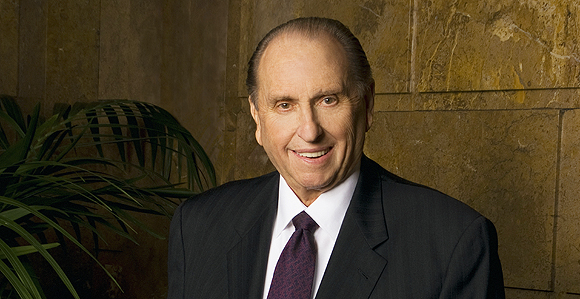President Monson’s Biography Released

“We all can do what he does.”
He prefers to eat Wheaties for breakfast, a habit from his childhood. Lime is his favorite yogurt flavor. He loves to read and has to finish any book he starts. He makes friends with everyone he meets and stops to talk to those he senses will be helped by his attention. He’s a world traveler, a devoted husband and father, and the leader of a global church that numbers in the millions. He has affected countless lives by reaching out to one at a time.
In President Thomas S. Monson’s biography, To the Rescue, released by Deseret Book on September 27, 2010, biographer Heidi S. Swinton relates many of the experiences that define the 16th President of The Church of Jesus Christ of Latter-day Saints.
Caring for Others
The neighborhood of his childhood shaped President Monson. His family was poor but not as poor as many of their neighbors, and his willingness to serve is clearly influenced by the caring examples of his parents and grandparents. By an early age, “Tommy” was offering the best he had to others, as when he gave away his two prized rabbits so that a friend’s family would have something to eat for Thanksgiving dinner.
As a bishop, President Monson constantly served within and without his ward. Once, as he was leaving the home of a widow in his ward, he met a woman who wanted someone to visit with her and her bedridden husband. Though she was not in his ward or even a member of the Church, a young Bishop Monson immediately visited the couple. He continued to visit them for months, eventually speaking at the husband’s funeral.
The prophet’s care for others is evident in the time he took—only minutes before being sustained as an Apostle—to respond to the concerns of a co-worker. Rather than brushing the co-worker aside, he listened carefully and assured the man of his prayers before proceeding to the general conference session that would mark a new chapter in his life.
After he became an Apostle, President Monson continued to give freely of the little time he had. Once he went to visit his mother at the hospital and ran into so many people asking for help that by the end of the evening he had visited two hospitals and given blessings to four people other than his mother.
Magnifying His Callings
When he was a deacon, Tommy, as he was known, watched a priest assigned to bless the sacrament fumble for the missing card that held the written prayers until the priest beside him took his place and gave the prayers from memory. Tommy’s respect soared for the priest who had “done his duty” in memorizing the sacrament prayers. He never forgot the lesson.
Throughout his life, President Monson has accepted and magnified every calling he has been given. He reached out to those who were lonely or less-active or in need in any way. When he was called to be a member of the Quorum of the Twelve Apostles, he told President David O. McKay that “any talent with which I might have been blessed would be extended in the service of the Master in putting my very life on the line if necessary.”
When the Korean War drew 23 of the young men in his ward to battle, then-Bishop Monson wrote each of them a letter every month. Another time, faced with a deacon’s theft of fast money, he went to the boy’s home to talk to him. Realizing that the boy’s family had no food and would soon be evicted, he recognized why the boy had stolen the money and worked to fix the family’s situation rather than confronting the boy.
A Heinrich Hofmann print of the Savior hangs in President Monson’s office, as it has in every office President Monson has had since he was called as a bishop. The painting has helped President Monson when he has had to make difficult decisions. When he looks at the Savior’s image, he considers what the Savior would do and tries to do it.
Loving His Family
No account of President Monson would be complete without including the role his family plays in his life. From a childhood spent surrounded by extended family—he treated their homes as though they were his own—to his immense love for his wife, Frances, and their children and grandchildren, President Monson would be incomplete without his family. It is considered an honor for him to tell someone that he has discussed their idea or shared some of their work with Sister Monson.
When Sister Monson spent a couple of weeks in a coma after a head injury in 2000, President Monson spent most of his time in the hospital with her. His son Clark said that his father was “determined not to lose” his beloved Frances. When Sister Monson finally awoke, President Monson was overjoyed. He once said, “If there ever was a heroine in my life, it would have to be Frances.”
President Monson worked to maintain the strong ties with his extended family, regularly visiting relatives. At family get-togethers with his parents, the whole family would sometimes make tape recordings for President Monson’s California-based sister Marjorie and her family.
Of family, President Monson taught, “As parents, we should remember that our lives may be the book from the family library which the children most treasure.”
President Monson believes that the service he has rendered on a day-to-day basis is not something beyond the reach of the ordinary person.
Biographer Heidi Swinton agrees. Summarizing what she has learned from her experience, she says, “We all can do what he does.”
